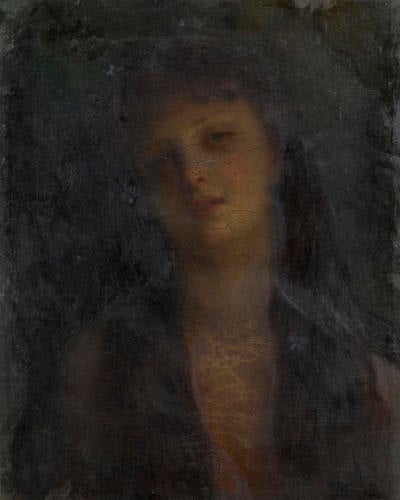Ophelia Signed and dated 1887
Oil on canvas | 49.3 x 39.5 cm (support, canvas/panel/stretcher external) | RCIN 406505
-
Ernest Hébert (1817-1908) was a French academic painter. Born in Grenoble, from the age of ten to took drawing lessons from Benjamin Rolland (1777-1855). However, to appease his father, who wished him to become a lawyer, Hébert began study law in Paris in 1834. While there, he also studied painting and drawing, first under Pierre-Jean David d'Angers and later with Paul Delaroche. In 1836 he entered the Ecole des Beaux-Arts and in 1839 won the Prix de Rome with the Cup of Joseph Found in the Sack of Benjamin. The success of his painting, Tasso in Prison Visited by Expilly (Grenoble, Mus. Peint. & Sculp., on loan to La Tronche, Mus. Hébert), acclaimed at the Salon of 1839, decided his career as a painter. In 1840 Hébert travelled to Rome to study at the Académie de France. The Director of the Académie on Hébert’s arrival was Jean-Auguste-Dominique Ingres, who exerted a great influence on him.
Hébert remained in Italy until 1847, working in Florence and Ischia, before returning to Paris via Marseille. Although his Salon submissions of 1848 and 1849 passed largely unnoticed, his Malaria of 1850 (Paris, Louvre, on loan to Paris, Mus. Hébert) was widely acclaimed, winning a first-class medal. The painting, which depicts a family of Italian peasants fleeing from a malaria epidemic, includes several sorrowful young women of the type that recurred in many of the artist's later works.
In 1853 Hébert again travelled to Italy, settling in Cervara, close to Rome, where he began painting the daily life and landscape of the area. Returning to Paris in 1858, he established himself as a society portraitist, in which capacity he achieved great popularity. Through the influence of the sculptor Émilien de Nieuwerkerke, whom he had met in 1839 on route to Italy, Hébert was appointed Director of the Académie de France in Rome in December 1866 and again in 1885. He retained this post until 1890 and remained in Rome until 1896. The Empress Eugenie was an admirer of his work; she purchased his Young Girl at the Well, and gave Ophelia to Queen Victoria in 1887.Works from this later period of Hébert's career, including this painting, have a dark spirituality with affinities to Symbolism. His handling of painting and use of colour are akin to those of his British contemporary George Frederick Watts. Ophelia, a character from Shakespeare's Hamlet, is the daughter of Polonius and potential bride of Prince Hamlet. Cruelly spurned by him (unfairly suspected of treachery), she becomes mad and drowns herself. As the epitome of fragile and tragic beauty she was a popular subject during the second half of the nineteenth century (famously portrayed by Sir John Everett Millais, 1851-2, Tate Britain). It is suggested in this ghostly image that, though in the bloom of youth, she hovers somewhere between life and death.
Provenance
Painted in Rome in 1887 and given to Queen Victoria by the Empress Eugenie for the Golden Jubilee 1887; Bethnal Green Museum 1888 to 1902; Osborne House March 1902; Buckingham Palace by May 1902.
-
Medium and techniques
Oil on canvas
Measurements
49.3 x 39.5 cm (support, canvas/panel/stretcher external)
106.4 x 96.8 x 9.5 cm (frame, external)
Category
Object type(s)








